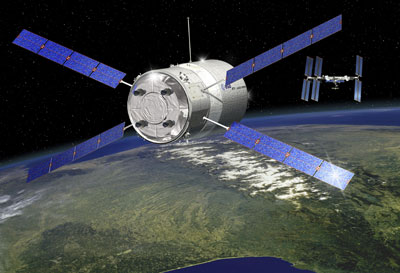ATV, Cygnus, and Dragonby Taylor Dinerman
|
| Once operational, the ATV will be the Rolls Royce of space delivery vans. |
France has long wanted to have an independent way of getting French and European astronauts into orbit. They tried to develop the Hermes space plane, a small shuttle-type vehicle, in the 1980s, but the program was too expensive and the other European states were not interested at that time in developing what was seen as one of Mitterrand’s “vanity” projects. Just because Hermes failed, though, did not mean that those inside the French establishment who supported the idea were ready to give up.
While France was reluctant to join the ISS program, the ATV at least was going to be a stepping-stone to their dream, as was the 1998 Atmospheric Reentry Demonstrator (ARD) experimental project. The great danger for Europe is that after the currently planned seven or so (depending on the source) ATV flights the system will be abandoned along with ESA’s investment in the ISS. The loss of expertise that would occur if the ATV were simply limited to these planned flights would be as bad as the nearly catastrophic loss of knowledge that hit NASA after the premature end of the Apollo program.
Meanwhile in the US, the Commercial Orbital Transportation Services (COTS) program is moving ahead. Elon Musk’s SpaceX company says that they have, so far, met all of the milestones associated with their COTS award. They already have a full-scale engineering model of the Dragon capsule that they are building for launch on their Falcon 9 rocket. The early version of the Dragon capsule is designed to carry cargo, both pressurized and unpressurized, to the ISS. The great difference between ATV and Dragon is that, right from the start, the US capsule was designed to be used to carry people into orbit.
The SpaceX capsule will be able to evolve rapidly and at minimal cost from a purely cargo-carrying system into a human-rated vehicle. This means that while the ATV will come into service years before Dragon—which, at best, will not deliver anything to the ISS before 2010 or 2011—it will be able to carry paying human customers into orbit long before the European vehicle.
If this plan comes anywhere near to reality, by the time the Europeans are flying a human-rated ATV-derived vehicle, SpaceX will have had years of experience flying people into and back from low Earth orbit. If they can keep their costs under control, they will have themselves a unique and extremely profitable (if temporary) near-monopoly on commercial human spaceflight. Russia, which now has such a monopoly, is limited in the number of seats they can sell each year. SpaceX could also service not just the ISS but other privately-owned orbital facilities (POOFs), such as those planned by Bigelow Aerospace (see “Inflatable POOFs”, The Space Review, July 19, 2004).
If Dragon fulfills its promise, the biggest potential problem will be to establish a universal docking mechanism and/or technique that can be used at both the ISS and on future POOFs. The plan is for the vehicle to approach the station and be grabbed by the remote manipulator and inserted into one of the slots on the Harmony node. Crews have considerable experience grabbing items from the Shuttle’s cargo bay, such as the Multi Purpose Logistics Modules (MPLMs), but only after the orbiter is docked to the ISS. Grabbing a spacecraft that is free floating alongside will be a new challenge.
Even if this problem can be overcome, there is no sign that Bigelow’s facility will have its own remote arm. Will the Russians agree to sell SpaceX their docking systems? That would not only go against Russia’s interest in maintaining their position, but would also run counter to the SpaceX in-house design and manufacturing doctrine. Will Robert Bigelow and Elon Musk come to an agreement on a standardized docking system? If so, who will pay for it and will it be available to other manned LEO systems and at what price? If the timing was right and they got lucky the intellectual property rights for such a system would repay the development costs several times over.
| If SpaceX can keep their costs under control, they could have themselves a unique and extremely profitable (if temporary) near-monopoly on commercial human spaceflight. |
A possible newcomer to this competition is Orbital Sciences Corporation’s Cygnus vehicle. Orbital won a funded COTS award last month that replaces the one lost by Rocketplane Kistler (RpK) when they failed to meet their financing requirements. Orbital has proposed to build a Cygnus cargo carrier with similar payload capacity to the Dragon and to be launched from their new Taurus 2 rocket. This rocket, which is to launch from Wallops Island in Virginia, will use the same Russian engines (modified by Aerojet) as the first stage as RpK’s K-1. As far as we know, however, the company has no plans to turn Cygnus into a human-rated system.
It’s much too early to know if Orbital’s Cygnus will have any significant advantages over either ATV or Dragon. In any case the competition is a complex one that depends in many ways as much on political decisions as it does on technological excellence. At the moment it looks as if SpaceX is best positioned to win the big prize and to become the world’s premier provider of commercial crew and cargo launch services to the ISS and to future POOFs. But they have not proven this yet. If they can successfully fly Falcon 1 this spring and Falcon 9 by the end of this year, it will show their real potential. If they fail, they will allow more time for their rivals to catch up.
This is going to be one of the space industry’s epic battles. It’s going to be fascinating.
